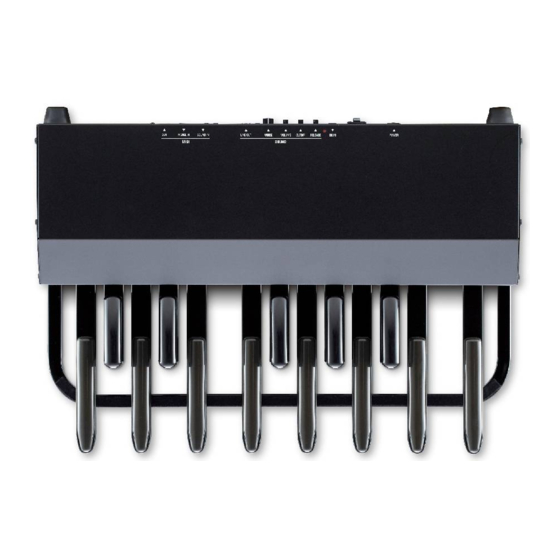
Advertisement
MIDI SOUND PEDALBOARD
Model:
Thank you, and congratulations on your choice of a Hammond
MIDI sound pedalboard!
The XPK-130G has 13 pedals (C to C), while the XPK-200G and
XPK-200GL both have 20 pedals (C to G). In addition, the XPK-200GL has
wooden naturals of extended length, to make "heel and toe" playing style
easier.
In addition to the MIDI capabilities, these units also contain 5 built-in Pedal
Voices, allowing you to use them as "stand-alone" units.
In order to get the most out of this instrument for many years to come,
please take the time to read this manual carefully and in its entirety.
Owner's Manual
Contents
P.2
P.4
P.5
P.6
P.8
P.9
P.10
OTHERS
P.12
Advertisement
Table of Contents

Subscribe to Our Youtube Channel
Summary of Contents for Hammond XPK-130G
-
Page 1: Table Of Contents
Thank you, and congratulations on your choice of a Hammond MIDI sound pedalboard! The XPK-130G has 13 pedals (C to C), while the XPK-200G and XPK-200GL both have 20 pedals (C to G). In addition, the XPK-200GL has wooden naturals of extended length, to make “heel and toe” playing style easier. -
Page 2: Important Safety Instructions
Objects have fallen into, or liquid has been spilled your retailer, the nearest Hammond, or authorized Hammond distributor, as listed on the “Service” page. onto the unit; or Th e unit has been exposed to rain (or otherwise has ... - Page 3 CAUTION Th e unit and the AC adaptor should be located so their Do not stand this unit with the cables connected to it, location or position does not interfere with their prop- which may cause damage to jacks and cables. er ventilation.
-
Page 4: Names And Functions
ACCESSORIES(XPK-200G/200GL only) ❶ Pedal keyboard er. Connect an audio cable from LINE OUT to the input Velocity-sensitive pedal keyboard. XPK-130G has 13 keys, connectors of an external amplifi er or powered speaker. XPK-200G/200GL both have 20 keys. SOUND IN jack ❷... -
Page 5: Mounting The Expression Pedal
Mounting the EXP-20 or V-20R XPK-200G or XPK-200GL. Please read the instructions ① Place the Expression Bracket 1 on top of the XPK-200G/ below on how to mount your particular Hammond Ex- 200GL as shown. pression Pedal. ② Fasten the Bracket to the XPK-200G/200GL by turning Mounting the EXP-100F/50/50J the two supplied knob bolts clockwise. -
Page 6: Making The Connections
MAKING THE CONNECTIONS HOW TO TURN THE POWER ON/OFF Preparing unit for use Power ON Power OFF ① Connect the AC adaptor AD2-1210/AD3-1210 into the DC IN jack on the unit. ② Hook the AC adaptor cord on the cord hook. ③... - Page 7 Hook-up example 2: Bass instrument AUX IN jack of a keyboard instrument. Use the cable Th is unit contains a built-in Sound Generator. Th erefore, types described in the fi gure below. you can play this unit as a “stand-alone” bass instrument as ②...
-
Page 8: Using The Internal Sound Generator
How to control the parameters by MIDI XPK-200G and the XPK-200GL will sound seven (7) more You can also select Pedal Voices and control parameters from an exter- notes than the XPK-130G because of the expanded number of pedal notes. nal MIDI controller. -
Page 9: Midi Channel, Merge
MIDI CHANNEL, MERGE Setting the MIDI channel Th is Advanced Feature allows you to change the MIDI Chan- nel on which the unit transmits and receives. You can select from “1” through “12. ” Th e default setting is Channel “3. ” To change the MIDI Channel, do the following: MIDI Channel NOTE: Doing the procedure below will set both the transmitting and... -
Page 10: Advanced Operation
ADVANCED OPERATION You can customize the operation of this unit with these Advanced Features. NOTE: These settings will be remembered even if the power to the unit is turned “OFF.” Auto Power OFF Th is allows you to select whether the unit will automatically turn “OFF”... - Page 11 Master Tune Th is allows you to change the master tuning of the built- in Sound Generator. You can select either “A=440Hz” or “A=442Hz. ” Th e default setting is “A =440Hz. ” To change the Master Tune, do the following: 440Hz ①...
-
Page 12: Midi Implementation Chart
MIDI IMPLEMENTATION CHART Date: 23-Jun.-2017 Hammond MIDI sound pedalboard MIDI Implementation Chart Version: 1.0 Model: XPK-130G/XPK-200G/XPK-200GL Function Transmitted Recognized Remarks Basic Default Changed 1 - 12 1-12 Channel Default Mode Messages Altered ***** XPK-130G 36 - 48 36-84 Note XPK-200G/200GL... -
Page 13: Specifications
SPECIFICATIONS XPK-130G XPK-200G XPK-200GL Sound Virtual Analog Sound Generator (monophonic, 24bit 32kHz) Generator Velocity-sensitive, wooden Keyboards Velocity-sensitive13-note Velocity-sensitive 20-note naturals*¹ 20-note Connections DC IN, MIDI OUT, MERGE IN, SOUND IN, LINE OUT User VOICE, VOLUME, CUTOFF, RELEASE Controls 560(W) x 400(D) x 105(H)mm... - Page 14 Although every attempt has been made to insure the accuracy of the descriptive contents of this Manual, total accuracy cannot be guaranteed. Should the owner require further assistance, inquiries should fi rst be made to your Authorized Hammond Dealer.



Need help?
Do you have a question about the XPK-130G and is the answer not in the manual?
Questions and answers